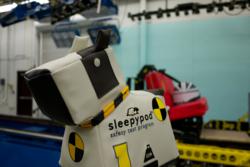
Pasadena, Calif. (PRWEB) June 15, 2012
Sleepypod today announces the results of testing pet restraint systems for cars in simulated car crash-tests. The company hired a U.S. Department of Transportation and National Highway Traffic Safety Administration sponsored crash-test facility to test the crash-worthiness of its entire line of pet carriers, a generic plastic pet carrier, and a generic pet safety harness, using a weighted, crash-test dog. In addition, to determine the effects of an auto crash on an unrestrained pet, testing of a crash-test dog without a restraint system was performed. Sleepypod used weighted crash-test dogs in each test to more accurately simulate a live pet and its force in a car crash. Videos of each simulated crash-test may be viewed at http://sleepypod.com/safety.
Crash-tests were performed at the speed of 30 m.p.h., which is the standard for child safety seats in the United States. There is no legal standard for the crash-worthiness of carriers or car restraint systems for pets, so the standard for crash-worthiness of child safety seats is the likely analogy. The current requirements of the Federal Motor Vehicle Safety Standard (FMVSS) No. 213, which subjects child safety seats to the decelerations they would experience in a severe vehicle crash, is that all child safety seats manufactured for use in the United States must pass a 30 m.p.h. frontal crash-test.
Sleepypod crash-tested its carriers alongside other soft carriers in an earlier test.
Pet Carrier Crash-test Results
Each of Sleepypods pet carriers passed a 30 m.p.h. frontal crash-test. Video footage shows that Sleepypods Pet Passenger Restraint Systems remained in tact and without damage. Video footage also demonstrates the crash-test dog remained inside the pet carrier throughout the duration of each test. Close-up before and after photos of the Sleepypod pet carriers are almost indistinguishable.
The unrestrained, generic plastic pet carrier hurled into a barrier before being catapulted upwards and landing on the ground with such tremendous impact that the carrier door broke off and the carriers plastic casing significantly cracked. Crash-testing of the generic pet safety harness yielded a strangled crash-test dog; the crash-test dog was propelled forward with so much force that the stitching on the harness came undone, the harness buckle broke, and the crash-test dog was caught by the neck in the harness which twisted and flung the strangled crash-test dog backward into the seat. Lastly, an unrestrained crash-test dog was thrust into a barrier with such force that its head was crushed on impact.
Sleepypod data demonstrates that an unrestrained pet in a car will propel forward and crash into whatever is in its path. The unrestrained plastic pet carrier carrying a 12 pound crash-test dog hit the barrier with 2000 pounds of force, while the unrestrained, 12 pound crash-test dog hit the barrier at 650 pounds of force. What is important to note is that proper restraints will evenly and safely transmit the forces of a collision to a car seatbelt system.
The Sleepypod carriers softened and dispersed a tremendous amount of force and kept the dogs safely inside the cushioned interior, says Michael Leung, one of Sleepypods co-owners and product designers. The before and after shots are almost identical. Other carriers that claim to be safe in car seats could not even remain in the test seat in lower speed collisions. Leung adds, Testing our products provides data to further improve our designs to keep pets safe.
At Sleepypod, we understand the importance of pets in their owners lives, adds Greg Mote, another Sleepypod co-owner and product designer. Keeping your pets safe during travel and at home is Sleepypods top priority.
About the Pet Restraint Systems Tested
In the recent set of crash-tests, Sleepypod tested its full line of pet carriers at the speed of 30 m.p.h.: Sleepypod, Sleepypod Air, Sleepypod Atom, and Sleepypod Mini. A generic plastic pet carrier, a generic pet safety harness, and an unrestrained crash-test dog were also tested.
Sleepypod tested its carriers alongside other soft carriers in an earlier test. Video and images of these tests may be viewed at http://sleepypod.com/safety.
About the Crash-test Dogs
Sleepypod designed and introduced MAX the Safety Dog in order to test and prove the benefits of pet restraint systems. MAX was weighted to 12 pounds to simulate a live pet and its force in a car crash. MAX was used in each of the crash tests except for the generic pet safety harness test. To obtain the proper harness fit, a facility test dog weighing 15 pounds was enlisted for that particular crash-test.
About Sleepypod
Bold and functional, Sleepypod products are clever enough to have won a slew of awards and stacks of praise from veterinarians, pet industry experts and media, even earning a spot in the Metropolitan Home Design 100 alongside iconic products like the iPhone and the Smartcar. Thoughtful design features transform ordinary pet products from insipid to inspired.
Busy pet-owner lifestyles demand pet products that are not only versatile but also exceptional enough to baby the pets that mean so much to us. Sleepypod understands the importance of pets in their owners lives and thats why we take pet safety seriously. With a pets well being in mind, careful and caring attention to every detail has been placed into each product from the crash-testing of the Sleepypod line of pet carriers for safety testing of the car seat function to the use of FDA food grade, BPA-free silicone in the Yummy Travel Bowls.
For information on Sleepypod and its products contact Jane Skuta at press (at) sleepypod (dot) com or (213) 341-1088, extension 5. Additional information may be found at http://sleepypod.com/
Related Interior Design Press Releases
